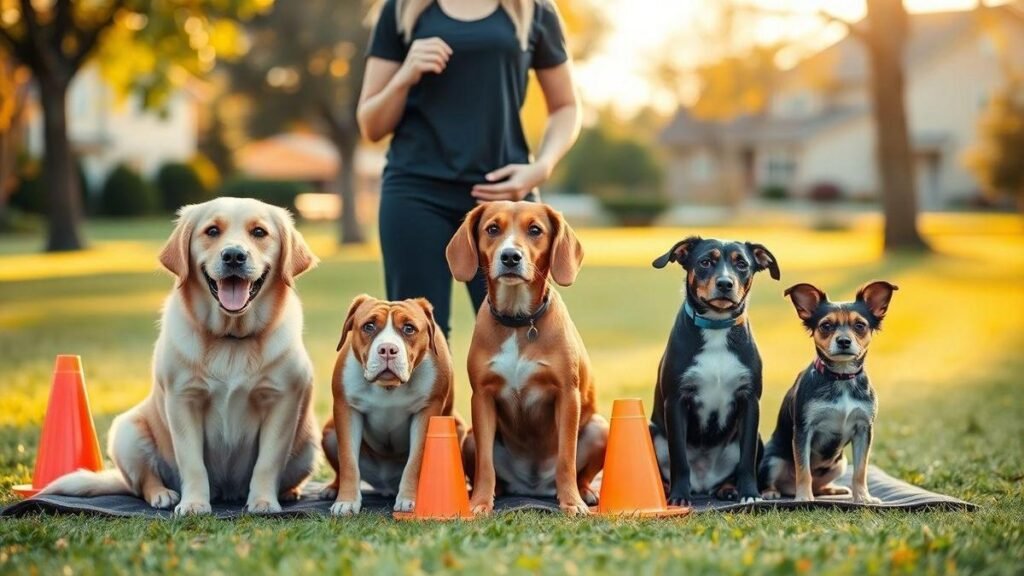Treinamento básico de obediência para cães adotados em casa — I guide you with kind, simple steps to help a rescue dog feel safe. I focus on gentle housebreaking and calm crate training, using positive reinforcement to teach sit, stay, and come in short sessions. I build calm leash manners, reliable recall, and slow socialization to ease fear. I set a simple daily schedule, track small wins, and grow trust together. For more on creating a safe start, see my tips on building trust with a newly adopted pet.
Key takeaway
- Be patient and gentle.
- Use treats and praise.
- Keep sessions short and fun.
- Practice short, calm walks.
- Provide a safe space and routine.
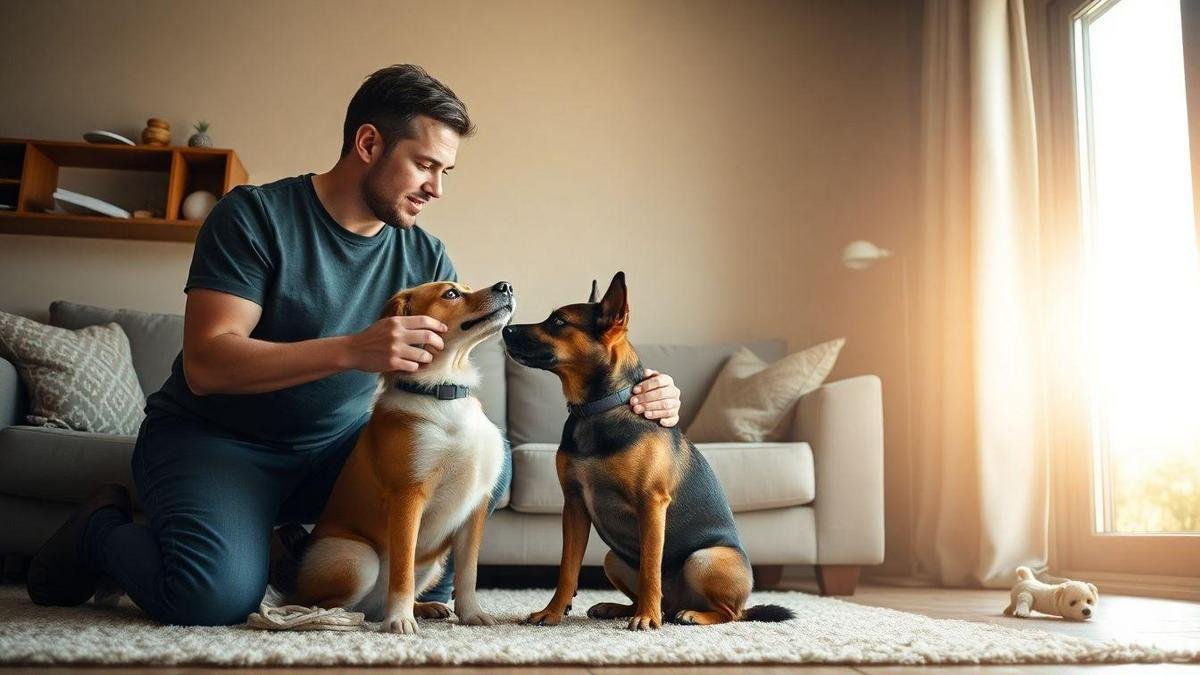
How I begin Treinamento básico de obediência para cães adotados em casa at home
I start with calm steps and clear goals. My adopted dog should feel safe, loved, and understood. I use short sessions, a soft voice, and lots of treats. I use simple cues and repeat them often. Patience and steadiness win. Preparing the space helps—see ideas on how to prepare your home for a new dog or cat and ways to help your pet adjust to a new indoor environment.
I focus first on housebreaking
I begin housebreaking the day my dog arrives: after waking, after meals, after play or naps, and before bed. I watch for signals—sniffing, circling, whining—and praise immediately when they go outside.
- Keep a consistent potty schedule.
- Clean accidents with an enzyme cleaner.
- Avoid punishment; reward the correct place.
Typical schedule:
- Wake-up: Take outside within 5 minutes.
- After meals: Take out 10–15 minutes after eating—mealtime routines help a lot; try using mealtime as a training opportunity.
- Play/rest breaks: Take out after play or naps.
- Before bed: Last trip outside to reduce overnight accidents.
A small success story: Max had three accidents the first week. With a steady schedule and praise, by week two he had far fewer mishaps and grew more confident. For more on building a steady routine, see how to build a daily routine for your indoor pet.
Crate training as a cozy den
Use the crate as a comfortable den, not a cage. Leave the door open, add soft bedding, and lure with treats—near the crate, just inside, then deeper. Never force the dog.
Steps:
- Introduce: door open, treats at entrance (1–2 days).
- Entering: treats inside, praise when they go in (2–5 days).
- Short stays: close the door for 1–5 minutes while nearby (several days).
- Longer stays: increase time to 30–60 minutes as comfort grows.
Make the crate part of daily life: a calm walk before travel or vet visits, a favorite toy inside, and sometimes a light blanket to make it cozier. Use a soft cue like den and never use the crate for punishment. If you need help preparing your dog for alone time, my guide on preparing your pet for indoor alone time has practical steps, and tips to help them feel safe are in how to help pets feel safe and confident indoors.
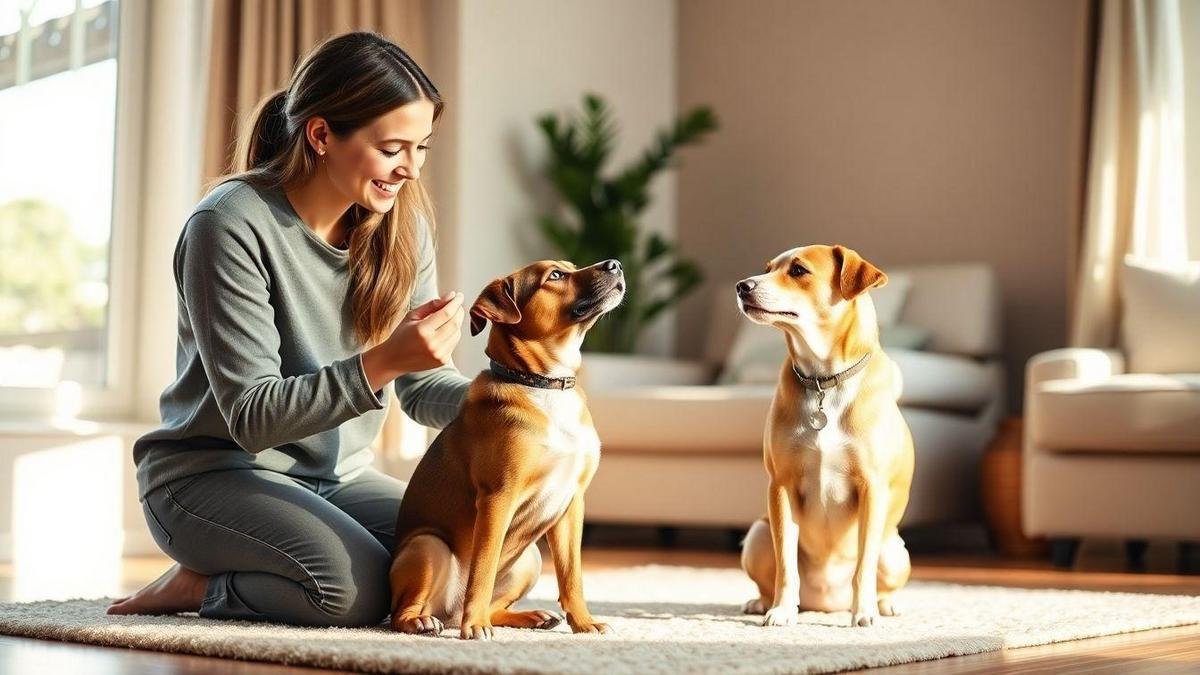
How I use positive reinforcement to teach basic commands
I train one command at a time with short rewards to keep the dog focused and happy. I mark the exact moment the dog performs the desired action (click or Yes!) and reward immediately.
Sit, stay, and come
- Sit: ask first, mark when the rear touches the ground, treat then praise.
- Stay: add time in tiny steps—1s, 2s, 5s—reward each success.
- Come: make yourself exciting—kneel, clap, use a cheerful voice. Never call to punish.
This is the core of Treinamento básico de obediência para cães adotados em casa: fast learning that preserves safety and trust. For settling and calm cues indoors, consider the method in teaching your dog to settle on command indoors.
Quick command table:
- Sit: cue gentle lift → small treat immediately.
- Stay: cue flat palm → treat praise after brief hold.
- Come: cheerful call open arms → high-value treat on arrival.
Shape behavior with tiny steps
Break big behaviors into micro-steps and reward the smallest improvement. Vary rewards—treats, toys, or praise—and always end sessions on a positive note.
Reward phases:
- Early: treat every success → build association.
- Middle: treats praise → add duration/distraction.
- Late: praise occasional treat → generalize behavior.
Track progress with short sessions
Train in short bursts: 3–6 minutes per trial, 5–8 trials per day. Record what you did and one clear goal for the next session. Celebrate small wins—two extra seconds of stay or a faster recall—with praise and small treats.
For fun training games that build connection and recall, try ideas from indoor games that strengthen your bond with your dog.
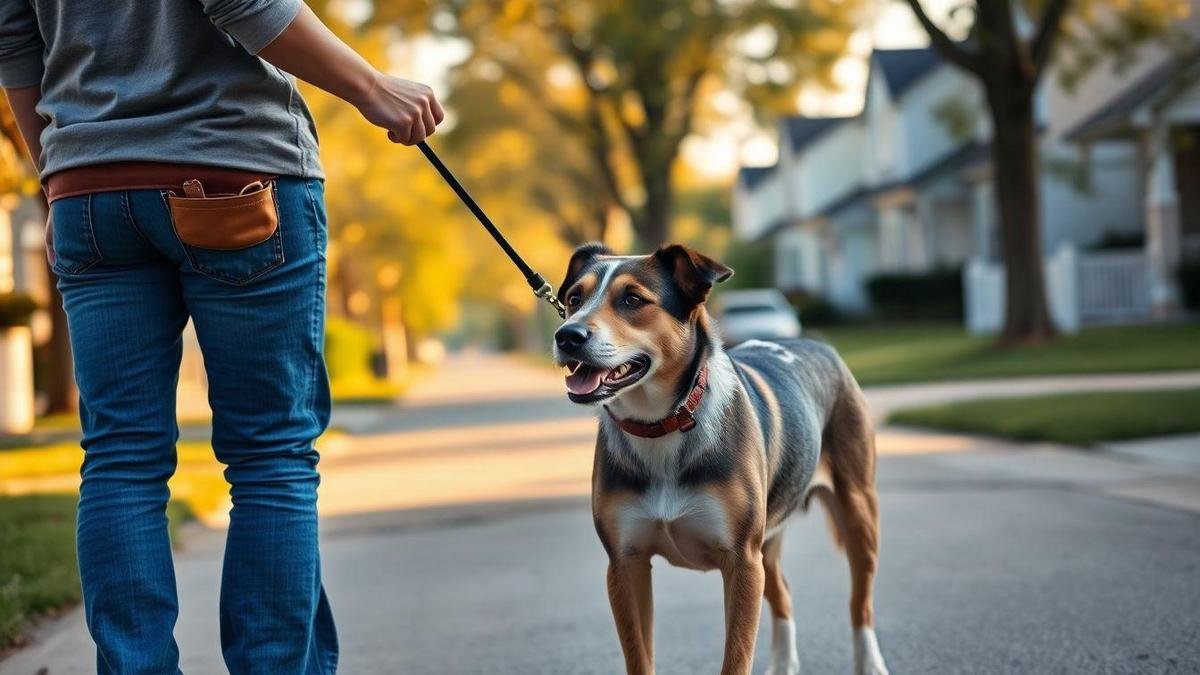
How I teach leash manners for adopted dogs
Start in a quiet area and keep walks short. Aim for a loose leash.
- If the dog pulls: stop and stand still until the leash relaxes—pulling gets us nowhere.
- Reward walking by your side with a treat and Yes. Reward the step next to you, not the sniffing spree.
- If pulling continues: change direction to regain attention. Mix stops, turns, and rewards to make walking a game.
Short lessons—5–10 minutes, 2–3 times daily—work best. Keep your tone calm and your cues consistent.
Reward calm behavior
Reward calmness immediately—sitting or quiet breathing at the curb earns treats and gentle praise. Use variable rewards (treat, toy, or walk forward) and redirect rather than punish bad behavior. Mix short obedience cues—sit, look, heel—into walks to build focus and trust.
Choose the right harness or collar
Select gear for comfort and control:
- Front-clip harness: best for pullers (redirects pulling).
- Back-clip harness: for calm walkers (comfortable).
- Flat collar: for well-trained dogs.
- Head halter: high control for strong pullers—use gently.
Check fit weekly—snug but not tight (two fingers under strap).
If you’re adjusting daily routes and times, see suggestions in best ways to help your dog adjust to a new routine indoors.

How I practice recall training to keep rescue dogs safe
Reliable recall is built with fun games and gradual distance.
Fun games and distance work
- Call from a few steps away and reward with a high-value treat on arrival. Keep it happy.
- Games: recall race (run away then call), hide-and-seek (call from behind cover), two-person recall (partner calls from another spot).
Progression:
- 2–5 ft, quiet room → tiny treat.
- 10–15 ft, backyard → favorite treat.
- 25–50 ft, fenced yard → toy treat.
- 50 ft, open area with long line → play session for off-leash recall in safe places.
Move only when the dog is confident at each stage.
Add distractions slowly
Introduce distractions like a dial: toy nearby, a person moving, another dog across the yard, then a busy park. Increase reward value as distractions rise—cheese, chicken, or a favorite tug toy becomes a super reward. That teaches: coming to me is the best choice.
Use a clear cue and high-value rewards
Pick one short cue (I use Here!) and use the same tone each time. The cue should never be associated with punishment. If the dog ignores the cue, step back and make the next call easier to rebuild success.
For building recall through play and focus, the ideas in indoor recall and bonding games are useful, and for practicing around other people or dogs, check how to socialize your pet in everyday situations.
Checklist:
- Single clear cue.
- Reward better than the distraction.
- Short sessions (5–7 minutes).
- End on a win.
How I help socialization and manage fear
Socialization should be slow, safe, and paired with rewards.
Introduce new people and dogs in small steps
- Start with brief, quiet meetings at distance.
- Parallel walks build comfort without face-to-face pressure.
- Exchange treats across a barrier to create positive links.
- Short, supervised play (1–2 minutes) if the dog shows calm signals.
Example: a shy pup relaxed after three days of passing a neighbor on walks—small steps, big change. For step-by-step introductions to other household pets, see how to introduce a new pet to your home and other pets and introducing a new puppy or kitten to older pets.
Spot fear and respond calmly
Watch for tucked tail, stiff body, lip licking, or freezing. Respond with a calm voice and soft movements, give space, and use treats to shift focus.
Quick responses:
- Tucked tail/low body: give space and lower your voice.
- Stiff/freeze: step back and toss a treat nearby.
- Whale eye/lip lift: pause interaction and offer a safe spot.
- Growl: stop approach and remove the trigger slowly.
Pair new experiences with high-value treats: toss meat bites when a stranger appears, give strong-smelling chews for another dog, or freeze-dried treats during calm car rides. For managing transitions and household changes, review how to keep pets calm during household changes.
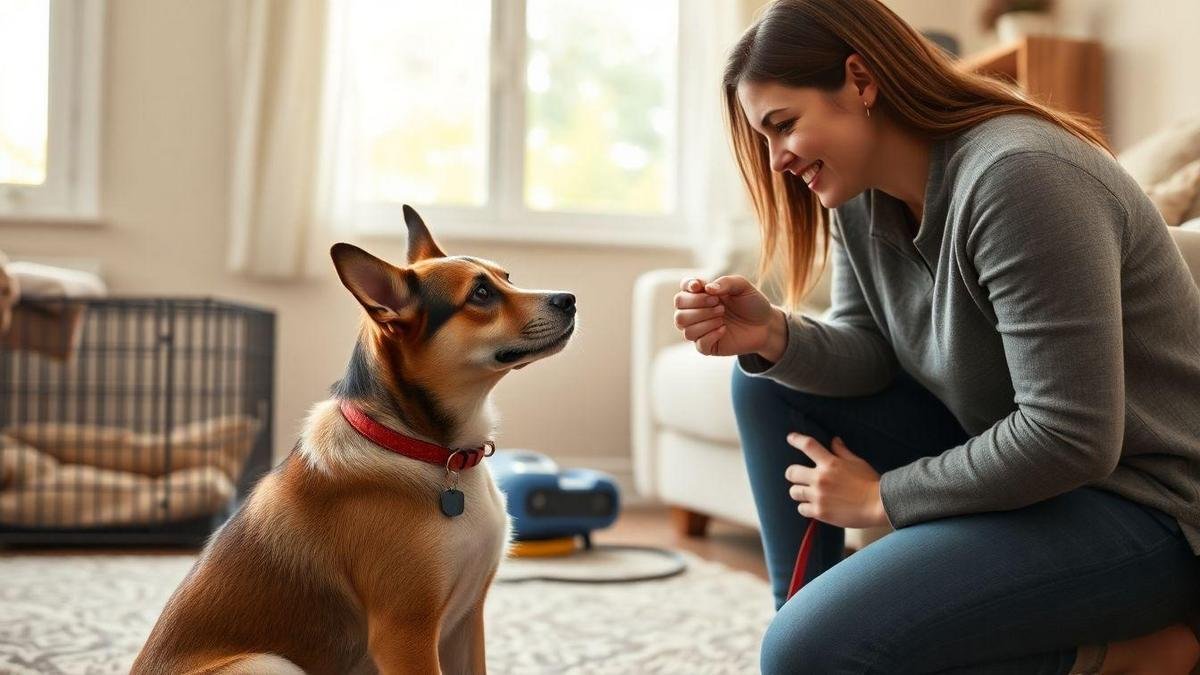
Long-term tips and routines for Treinamento básico de obediência para cães adotados em casa
Patience wins. My plan centers on daily routines, clear goals, and steady praise. Build trust first, then add training steps. Short sessions and lots of rewards make learning stick.
Daily schedule to build trust
A consistent routine helps a dog feel safe. Short sessions—5–10 minutes, 3–4 times a day—work well.
Sample day:
- Morning (10 min): short walk name practice → focus and loose leash. For a calm start, see creating a calm morning routine.
- Midday (5–10 min): sit and settle → calmness and reward.
- Afternoon (5–10 min): recall practice in yard → reliable return.
- Evening (5–10 min): gentle handling and praise → comfort with touch—use the daily touch-check routine to build confidence.
Adjust to your dog’s mood: stop when tired, add praise when excited. Note one small win each day.
Work with a vet or trainer when needed
Call a vet for health checks and a trainer for behavior help. Ask specific questions like Why does he freeze? or How to stop leash pulling without fear? Use their exercises at home and take notes. For general care and questions, see the guide to caring for pets.
Who to contact:
- Vet: check health, pain, meds—once after adoption, then as needed.
- Trainer: behavior tips and drills—1–3 sessions then check-ins.
Keep goals simple, track wins, and adjust
Make goals tiny and clear: three sits in a row, five calm minutes walking, two recalls today. Mark wins and raise the bar slightly when ready.
Small goal table:
- Sit: 3 sits in a row → add distance or another sit.
- Recall: come twice in yard → practice with mild distraction.
- Leash walk: 5 calm minutes → add time or change route.
Celebrate each win with a treat, a hug, and a happy voice. Stay flexible and kind.
Conclusion
Welcoming a rescue dog can feel like new territory. Use gentle, reward-based steps so your dog feels safe, seen, and loved. Short joyful sessions, clear cues, and steady positive reinforcement teach the basics—housebreaking, crate training, sit, stay, come, calm leash manners, and reliable recall—one small win at a time.
My plan is simple: build trust first, add routines next, track tiny victories, slow the pace for fear, and pair new experiences with high-value rewards. Call a vet or trainer when needed. Patience and consistency are the glue; praise and treats are the map.
You don’t need perfection—just a handful of clear rules, short practices, and a lot of warmth. I’ve seen shy dogs become confident companions with this approach. For more ideas and step-by-step examples, visit our care and training guides.
Frequently asked questions
Q: How do I start basic obedience training with my adopted dog?
A: Start with one soft command, tiny treats, and 5-minute sessions. Follow Treinamento básico de obediência para cães adotados em casa steps: sit, come, stay.
Q: How long will it take to learn sit and stay?
A: Expect small wins in days and stronger habits in weeks. Stay patient and upbeat.
Q: What if my adopted dog is scared or reactive during training?
A: Slow down, give space, use calm rewards, and ask a trainer for help if needed. See tips on keeping pets calm during changes and gradual socialization.
Q: How often should I train my adopted dog each day?
A: Three to five short sessions a day, mixing training into walks and play. Keep it fun.
Q: What rewards work best for adopted dogs?
A: Tiny tasty treats, praise, and quick play. Switch rewards if interest fades.
(Reminder: Treinamento básico de obediência para cães adotados em casa works best when you pair clear cues with kindness and consistency.)

